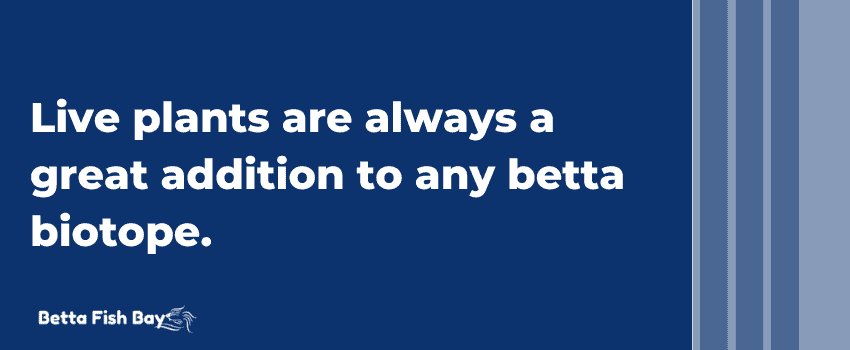Biotope habitats mimic the native environment of a fish species.
A betta biotope usually contains aquatic plant species native to Southeast Asia. Indian almond leaves and driftwood release tannins for blackwater conditions.
Creating a biotope gives your betta an ideal living space and a healthy tank ecosystem.
But are there other benefits of a betta biotope?
The aquatic plants and blackwater conditions of a betta biotope reduce stress levels in your fish by providing a sense of security. Betta biotopes also have improved water quality and a more balanced biological ecosystem. A betta biotope keeps your fish healthier and gives your tank a unique look.

Table of Contents
The Natural Habitat of Betta Fish
There are 73 different recognized species of betta fish.
Most of the bettas you find in pet stores are betta splendens. Betta splendens are more popular than other wild betta species because of their bright colors and flowy fins.
Wild betta fish are usually more expensive and difficult to find. Some sought-after wild betta species include:
- Betta imbellis
- Betta macrostoma
- Betta smaragdina
- Betta mahachaiensis
- Betta Albimarginata
- Betta Mahachai
All betta fish species come from parts of Southeast Asia. This includes Thailand, Cambodia, Laos, and Malaysia.
The betta’s native habitat consists of shallow bodies of water such as rice paddies, streams, and forest swamps.
These shallow waters contain layers of leaf litter, fallen branches, and a variety of native freshwater plants.
Tannins give the water a brown color and lower the pH. The dark water and plant matter allow wild bettas to hide from predators.
The betta mahachaiensis prefers brackish water conditions. This is rare among bettas.
A substrate in the shallow waters of wild bettas usually consists of peat or a sandy soil mixture.
Recreating a betta’s natural environment is not difficult. Most aquarium plants and decorations are available at your local fish store or online retailers.
The Benefits of a Betta Fish Biotope

Setting up a biotope is a great way to learn more about your betta’s native habitat.
Understanding your betta’s native ecosystem helps you provide your fish the most natural living space.
A biotope also offers you and your betta several benefits.
Lower Stress for Your Betta
Dark water and lots of plant life make wild bettas feel more secure.
The same goes for your domestic betta. This is true even if your betta comes from a tank with colorless water.
When your betta feels secure, it is less stressed about its surroundings. Lowered stress levels prevent your betta from being prone to illness.
Improved Betta Health
Besides lowered stress levels, creating a biotope improves your betta’s health.
The tannins used in creating a betta biotope contain antioxidants. They also have antibacterial properties.
Using tannins in your betta biotope protects your fish better against harmful bacteria and certain fungi.
The benefits to your betta include a more robust immune system and healthy growth. Your betta may even have an increased lifespan.
Tannins also buffer the amount of light in your aquarium. This prevents excessive algae growth.
And your betta is not the only one to enjoy a biotope habitat. If you have shrimp in your betta tank, they will also have improved health.
Tannins boost a shrimp’s metabolism and encourage molting. The decaying plant matter from Indian almond leaves also provides a food source for shrimp.
Improved Water Quality and Balance
Tannins also affect your betta tank’s water quality.
As tannins release into the water, they bind to minerals. This binding process lowers the pH and hardness.
Adding tannins to your betta tank is especially helpful if you have hard tap water.
Tannins also aid in the nitrogen cycle due to decomposing botanicals like Indian almond leaves. This decomposition feeds the beneficial bacteria in the nitrogen cycle.
A healthy nitrogen cycle creates balanced water parameters by processing ammonia and nitrites.
Testing your water parameters weekly is always essential, especially if you add tannins to your betta tank.
You must ensure the pH does not get too low. The ideal pH for bettas ranges from 6.5-7.0, but this may vary according to betta species.
Always research the betta species you have chosen before setting up your tank. This ensures you provide your betta with the exact habitat to thrive.
Ideal Water Parameters for a Betta Fish Tank Include the following:
- Temperature: 78-80° degrees Fahrenheit (25.5-27° C)
- pH: 6.5-7.5
- Ammonia and Nitrite: 0 ppm
- Nitrate: < 40 ppm
- gH: 3-4 dGH (50-66.7 ppm)
- kH: 3-5 dKH (53.6-89.4 ppm)
- Minimum Tank Size: 5 Gallons
Aesthetically Pleasing Aquarium
Besides creating a healthier environment for your betta, a biotope has an appealing aquascape.
The dark water of a betta biotope gives your aquarium a unique look.
A major factor in the appearance of your betta biotope is the placement of aquarium plants and decorative elements.
Take some time planning your biotope aquascape, and do not be afraid to rearrange things for a balanced look.
Some aquarium hobbyists do not like the looks of a tank with blackwater conditions. They worry it will not show off their colorful betta.
But when done right, a betta biotope showcases your fish and provides a much healthier ecosystem.
How To Create a Betta Fish Biotope

Creating a betta biotope is not only for advanced hobbyists. Even a beginner hobbyist can create an amazing biotope aquascape with some research.
You must consider the needs of your betta first when planning a biotope.
While adding many plants and decorations is exciting, it is easy to get carried away. You do not want to overcrowd your betta until it has nowhere to swim.
Before you get started, consider what you need for your betta biotope:
- Appropriately-sized tank
- Heater
- Filter
- Substrate
- Plants
- Decorative elements
- Blackwater tinting medium
Planning out your betta biotope beforehand helps you create a complete habitat.
Tank Size
The first thing you must consider is the tank size for your betta biotope.
Bettas can live in tanks as small as 5 gallons.
But a larger tank is the better choice if you are planning an elaborate biotope.
A 10- or 20-gallon tank gives your more space for plants and decorations without overcrowding your betta. Creating a new habitat does no good if your betta does not have adequate swimming space.
Larger tanks also accommodate more hiding spots like driftwood and smooth rocks.
You must ensure the tank has more horizontal space than height. Bettas live in shallow waters and have trouble swimming to the top of taller tanks.
Swimming to the surface is necessary for bettas to feed and breathe in some fresh air.
Potential tank mates are another factor in the tank size of your betta biotope.
You need at least a 10-gallon tank for snails and shrimps.
Some excellent tank mates for your betta in a blackwater biotope include:
- Mystery snails
- Zebra nerite snails
- Amano shrimp
- Ghost shrimp
These small tank mates add visual interest to your betta biotope. They are also excellent tank cleaners because they feed on algae and decomposing plant matter.
Check out our picks for the top tank mates for betta fish.
Filtration System and Heater

Next, you need a proper filtration system and aquarium heater.
Some aquarium hobbyists claim a filter is not needed for a biotope setup. But proper water circulation maintains stable oxygen levels and ensures even heating.
Bettas cannot swim well in strong currents. Stronger currents may also disrupt the tannins for your blackwater conditions.
A sponge filter with an adjustable flow is the ideal aquarium filter for bettas.
The filter must cycle all the water in your tank 4-6 times per hour. Choose a filter with a GPH rating between 40-60 for a 10-gallon tank.
Avoid using chemical filter media because it will leech the tannins from the water.
Bettas are tropical fish and must have warm water to stay healthy. The ideal temperature for betta fish ranges from 78-80° degrees Fahrenheit (25.5-27° C).
Maintaining these warm temperatures is only possible with an aquarium heater.
Choose a fully submersible heater with an easy-to-read thermostat. Also, invest in a separate thermometer in case the thermostat fails.
The recommended wattage for an aquarium heater is 3-5 watts for every gallon of water. A 30-50 watt heater is suitable for a 10-gallon tank.
Lighting
Aquarium lighting is necessary for maintaining the healthy growth of your aquatic plants. Bettas also need a day and night light cycle to regulate their eating and sleeping habits.
LED lighting is the standard for aquariums because it does not produce a lot of heat.
Getting the right balance of lighting for a betta biotope is challenging.
Too much light causes excess algae growth. Low light may not penetrate the dark water enough to support healthy plant growth.
This LED aquarium light features adjustable brightness and color temperature settings. It also has a gradual on-and-off function, which simulates sunrise and sunset.
With this type of light, you may adjust the brightness to suit the needs of your betta biotope.
Consider the lighting needs of your live plants when choosing a lighting system for your betta biotope. Low-light plants are more manageable in a tank with blackwater conditions.
Water Parameters
Stable water parameters are crucial for your betta’s health. Dirty tank water is unacceptable no matter what type of setup you have.
Test your water parameters weekly with a quality aquarium testing kit. Tannins do not usually have an extreme effect on pH levels, but you do not want them becoming too acidic for your betta.
You must also ensure no toxins like ammonia and nitrite in your water.
Weekly partial water changes remove these harmful toxins and stabilize your water parameters.
Aim for removing no more than 20% of the tank water at one time. Removing more than this may disrupt your nitrogen cycle.
Always treat tap water with a dechlorinator before adding it to your betta tank. Chlorine and chloramine are deadly to fish.
Blackwater Tinting Medium
There are several ways of achieving blackwater conditions in your betta biotope.
Common blackwater tinting mediums include:
- Driftwood
- Indian almond leaves
- Oak leaves
- Alder cones
- Rooibos tea
You may also buy concentrated tannins or make your own by boiling Indian almond leaves.
Some tinting mediums make the water darker than others.
For example, Malaysian driftwood releases more tannins than other driftwood varieties. Rooibos tea has a reddish tint.
Decide what kind of look you are going for when choosing a blackwater tinting medium.
Whichever tinting medium you choose, you must add it slowly.
Start with 2-3 botanical pieces for every 5 gallons of water. After a few days, test the water chemistry and ensure you are within the correct parameters.
Add more pieces until the dyed water is to your liking. Always test your water parameters when adding more aquarium botanicals.
You may need to add more tannins to the biotope as the color lightens after a few water changes.
Live Plants

There are several live plant choices available for your betta biotope.
Some excellent plant choices include:
- Blyxa japonica (common rice paddy plant)
- Crinum thianum (onion plant)
- Java fern
- Java moss
- Dwarf aquarium lily
- Red tiger lotus
- Hornwort
- Kleiner Bar Sword
- Anubias nana petite
Some plants need a soil substrate for essential nutrients. Other plants, like moss, can grow in cracks in driftwood.
Floating plants have hanging roots and add visual interest to your betta biotope.
Proper plant placement is crucial for an appealing aquascape. Place taller, bushier plants near the back of the tank, so they do not crowd out the shorter plants.
Keep your lighting system in mind when placing plants in the tank. You must ensure your plants receive enough light so they can thrive.
Trim excess plant growth every 2-3 months. This prevents the plants from overgrowing and crowding your biotope space.
Substrate
The substrate in a betta’s natural habitat usually consists of sandy soil or peat. These types of substrates are difficult to clean in a betta tank.
Adding a layer of gravel over a soil substrate offers easier maintenance.
Aquarium soil is the ideal substrate for a biotope because it provides your plants with essential nutrients. The thin layer of gravel substrate on top prevents the soil from becoming too messy and is less of a challenge for cleaning.
You must consider the color of your substrate in a betta biotope. A dark substrate creates a more natural appearance and mimics a betta’s native habitat.
The ideal substrate depth is 2-3″ inches with an added inch of substrate topper. This provides enough depth for rooted plants.
Slope the substrate towards the back of the tank for a better visual appearance.
Clean the surface of the substrate with a gravel vacuum when performing water changes. This removes uneaten food and fish waste, which can interfere with your water parameters.
Tank Decorations
Tank decorations for a betta biotope should be simple.
A Spongebob pineapple would look out of place in a native habitat!
Besides driftwood, you may add smooth rocks or twigs for a natural look.
Always ensure your tank decorations do not have any sharp edges or rough textures. Bettas have delicate fins and may become injured by sharp objects or coarse surfaces.
Leave some extra space around your decorations so your betta does not get stuck between them and the sides of the tank.
Read more about caves for betta fish and why they are a great idea.
Making Your Betta Feel At Home
Creating a biotope for your betta keeps your fish happy and healthy.
A natural environment makes your betta less stressed and gives your tank an aesthetically pleasing look.
Planning a betta biotope is also a fun way to learn more about your betta’s origins.
Always remember your betta’s health and safety when setting up a new environment.
If your betta is not adjusting well to your setup, do not hesitate to make some necessary changes.


